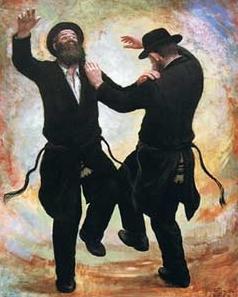Jewish dance can be called an integral part of the rich culture of this ancient people. According to legend, the Jews began to dance for the first time immediately after they gained the Torah, at the foot of Mount Sinai. True, they say that the circumstances of their first dances were not as pious as is commonly assumed. People were simply tired of waiting for Moses to talk to the Lord, so they built an idol, a little calf made of gold, offered sacrifices to him, and then they danced and chanted around him. It was this behavior of the Jews that became the reason why the tablets were broken: Moses was indignant at what he saw and in anger threw them with such force that they split on the mountain.
There is also a mention of how the Jewish princess Salome performed the Jewish dance of seven veils in front of King Herod. He was so fascinated that he vowed to fulfill everything that the girl desires. And she wished the death of the prophet
John the Baptist - and his head was brought to her on a platter. As for the history itself, the facts are known that the Polish gentry during the time of the
Polish-Lithuanian Commonwealth loved to be entertained by the fact that they made every Jewish Jew dance the Mayufis wedding dance to the Sabbath anthem. This was considered humiliating, and subsequently the phrase "dance mayufis" became a household word and was used in the meaning of "fool, grovel in front of someone."
It is traditionally believed that religion is not allowed for Jews to perform joint dances, that is, women should not dance with men - only separately from them. But this is only partly true, since so many movements of Judaism fully allow the Jewish dance to be performed all together. Moreover, even special dance evenings are practiced, in which young men get acquainted with girls with the aim of creating a family in the near future (it is not customary for Jews to meet and care for too long, most often a guy will be determined after the first or second meeting, he will marry a specific girl or not).

Of particular note is the Hava Nagila dance. This Hebrew name translates as “Let's rejoice,” and initially there was only a song. Abraham Zvi Idelson wrote it, taking as a basis the Hasidic ancient melody. At one time, he studied the folklore of his people and heard the melody of a future masterpiece by chance in 1915. He inscribed it in his notebook, where a large number of other melodies, legends and traditions have already gathered. He came up with words for her later. He dedicated his song to the holiday that came for all Jews at the moment when the Balfour Declaration was issued, giving the people the right to build their state on one of the sites belonging to Palestine.
But since it was a song of joy, it simply could not but develop into Jewish dances. "Hawa Nagila" is very simple in its execution. The words of the song are as unpretentious as the dance movements, so even those who have never danced “Hawa Nagila” will have no difficulty remembering them. She is so incendiary that to this day they sing and dance at every celebration, gathered in a friendly, cheerful round dance. The beginning of the dance is slow, but gradually the melody accelerates, and after it the movements of the dancers speed up, which causes a lot of positive emotions.